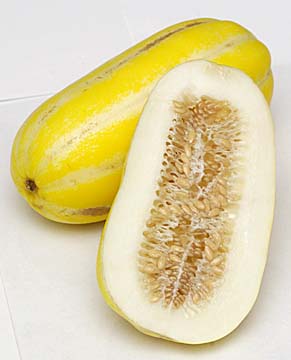

Key Ingredient

You might have seen this variety of melon pop up throughout the summer at farmer's markets, smaller Asian markets or around Chinatown. KOREAN MELON
They've been around for a couple of years but have remained quite obscure. Nonetheless, try and hunt this melon down. You have until the end of summer to do so.
The basics: Golden melon, also called Korean yellow melon, is a hybrid sweet melon that has been popular with the Korean community as well as throughout Asia. Not only is it juicy and sweet, but it comes in a convenient, petite package, averaging about 1 1/2 pounds.
The outer skin, or rind, is a distinct bright yellow, with white indented stripes running from end to end. The flesh is cream-colored with a crunchy, pear-like texture. The taste has been compared to cantaloupe, although it is more like a cross between cantaloupe and honeydew melon. It is grown locally on Oahu by Aloun Farms but is also brought in from California.
Selecting: Look for melons that are heavy for their size. They don't emit much of a fragrance except when overripe. These melons are a bit more delicate than other varieties of melons and tend to brown quickly. Avoid melons with soft spots and bruising.
Storing: Refrigerate golden melons for no longer than five days. Ideally, they should be eaten as soon as possible after purchase.
Use: Cut melon in half and remove seeds. Cut off the rind and chop into bite-size cubes, or enjoy the crunchy flesh with a spoon, scraping the meat off the rind.
Where to buy: You may have to hunt a bit for this melon. Daiei and Star Markets are the two larger markets that have started carrying it on a limited basis. Chinatown and farmer's markets are the other sources. The melons run $1.69 to $1.99 a pound.
Food Stuffs: Morsels
Contact Eleanor Nakama-Mitsunaga
online through features@starbulletin.com